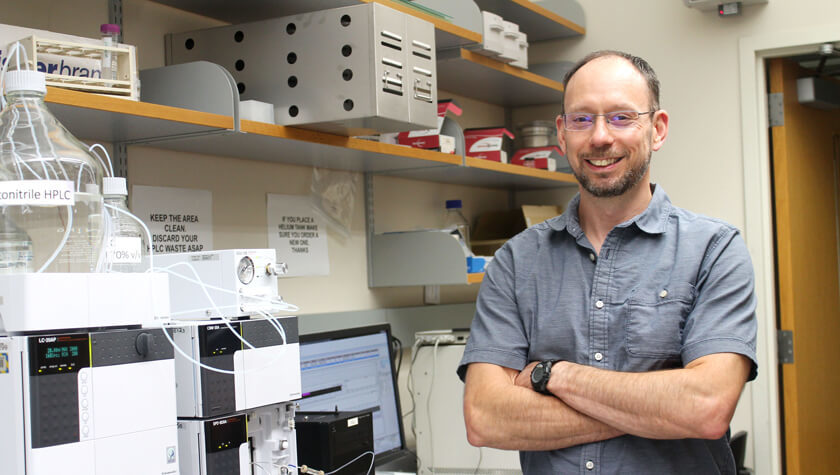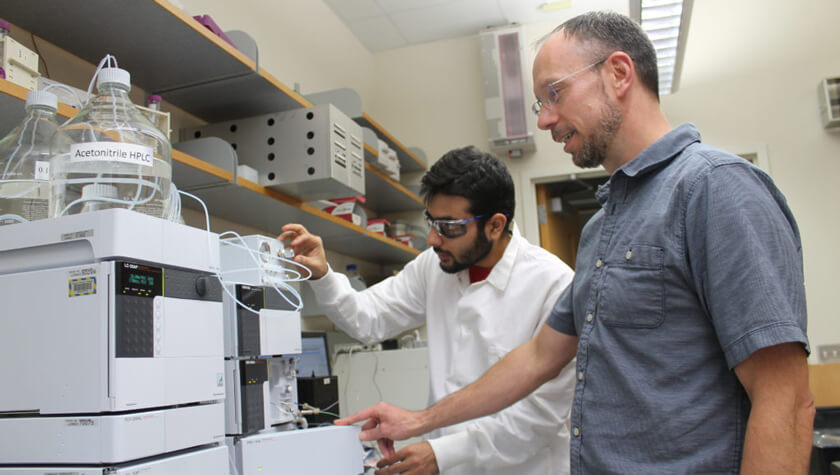
6
June

Professor Tim Bugni and his colleagues are taking aim at the growing threat of multi-drug-resistant pathogens for which few — or no — treatment options exist
By Jill Sakai
Thanks to the ready availability of antibiotics, basic infections today no longer pose the danger they did a century ago. But extensive use of common drugs, combined with pathogens’ impressive capability to evolve ways to evade them, have made antibiotic resistance a major challenge in health care. That leaves few treatment options against pathogens such as multi-drug resistant Escherichia coli or the emerging — and particularly worrisome — fungal infection Candida auris.
Tim Bugni, a professor in the Pharmaceutical Sciences Division of the University of Wisconsin–Madison School of Pharmacy, is working to fill the growing need for new antibiotics. With a new five-year, $30 million grant from the National Institutes of Health (NIH), he and his colleagues are searching out novel compounds to fight the most problematic and difficult-to-treat infections: multi-drug-resistant fungi and gram-negative bacteria.
“These are emerging in clinics throughout the United States,” says Bugni. “There are gram-negative pathogens that are resistant to every antibiotic we have, and strains of Candida auris that are resistant to every antifungal agent.” These emerging infections cause thousands of deaths each year; for some strains, mortality can exceed 50 percent.
Fighting the toughest foes
Five years ago, Bugni and his collaborators, including David Andes in the UW Department of Medicine and Cameron Currie in the UW Department of Bacteriology, secured NIH funding for a Center of Excellence for Translational Research, one of 14 CETRs around the country established to speed the process of getting basic research into the clinic. They started looking for molecules that could kill methicillin-resistant Staphylococcus aureus, often known as MRSA.
MRSA is still a big problem, Bugni says. But with many promising options in its pipeline, the team is shifting its sights to harder targets. “The chance that someone will find a new antibiotic for MRSA is pretty good. Whereas the highly problematic gram-negative pathogens — nobody has had any success finding a strategy that works,” he says.
“It’s like the nastier the pathogen and the disease, the better this molecule [turbinmicin] is working.” –Tim Bugni
Gram-negative bacteria are defined by the composition and properties of a protective outer membrane, which resists a colored dye called Gram stain. That membrane, combined with cellular pumps that efficiently oust drug compounds, make these microbes notoriously tough to treat. “I don’t think anybody would argue that it’s the most difficult drug discovery target that you can go after,” Bugni says.
Most current antibiotics have been developed from bacteria that live in the soil — and while it’s likely that undiscovered molecules still lurk in soil environments, picking out something new from a sea of already-knowns is against the odds. Plus, even novel compounds from soil may be ill-equipped to tackle pathogens that are already resistant to other antibiotics sourced from the same environment.
Overcoming a problem as large as antibiotic resistance won’t come through incremental change, Bugni says. With the new round of funding — nearly double the initial NIH grant for the Center — “what we’re trying to do is find things that work in a completely different mechanism, have completely different structures, do something completely different.”
A different focus
To find that novelty, Bugni and his colleagues are looking in a different type of environment: other creatures. They target bacteria that have co-evolved in a symbiotic relationship with an animal host. The idea is that such symbiotic systems may preferentially support bacteria that make molecules that help their hosts — and, importantly, are not toxic to those more complex cells.

Currie leads the team’s efforts studying bacteria associated with insects, while Bugni focuses on those that live in marine sponges and other sea-dwelling invertebrates.
Researchers have known for quite a while that marine sponges are loaded with interesting molecules, Bugni says. But “those molecules actually aren’t made by the marine sponge at all — they’re actually made by symbiotic microorganisms within the animal,” he says. “If you look at a marine sponge, 50 to 70 percent of its volume is actually bacteria.”
The researchers collect bacteria from the host animals, then screen as many as possible to find those making the most promising new chemical structures. Bugni’s research group specializes in building powerful analytical tools to boost this process, such as an automated pipeline that uses computer algorithms to analyze chemical profiles and generate a readout of small molecules that are unique to each bacterium. The team can scan many such profiles for chemical structures that are likely to be new kinds of molecules.
Then they pit the most interesting molecules against their most challenging targets right away. They start with tests against the milder family member Candida albicans, then move to the tougher Candida auris and Candida glabrata. That strategy zeroes in on just the kinds of antimicrobial activity they want to isolate and prioritizes the best candidates for further study.
One of their most exciting leads to date, an antifungal agent isolated in the Bugni Lab that they’ve named turbinmicin, appears to check off the most desirable qualities: potent killing power against all the most pernicious fungal pathogens, including Candida auris and drug-resistant Aspergillus fumigatus; prevention of the tough biofilms that shield pathogens against most treatments; and, importantly, tackling a different biological target than current drugs, making it less prone to existing resistance mechanisms.
“Part of what we’re trying to do with this Center is identify a sustainable pipeline of development, for decades to come.” –Tim Bugni
“The situations where nothing works? That’s where turbinmicin seems to fit,” says Bugni. “It’s like the nastier the pathogen and the disease, the better this molecule is working.”
They’re now using a similar approach in search of compounds that target gram-negative bacteria. Five years from now, he says, his primary goal is a true gram-negative antibiotic — not just in the lab, but one that they’ve shown safe and effective in test animals. It’s a steep goal, but, he thinks, attainable.
Even a successful search will be just the beginning, Bugni knows. Inevitably, bacteria will develop resistance to new drugs. “It’s just a matter of time,” he says. So the team hopes their approach will also establish a way to continue sourcing powerful novel antibiotics. “Part of what we’re trying to do with this Center is identify a sustainable pipeline of development, for decades to come.”
Learn about more about Dr. Bugni’s research and another antibiotic discovered in the Bugni Lab: keyicin.




